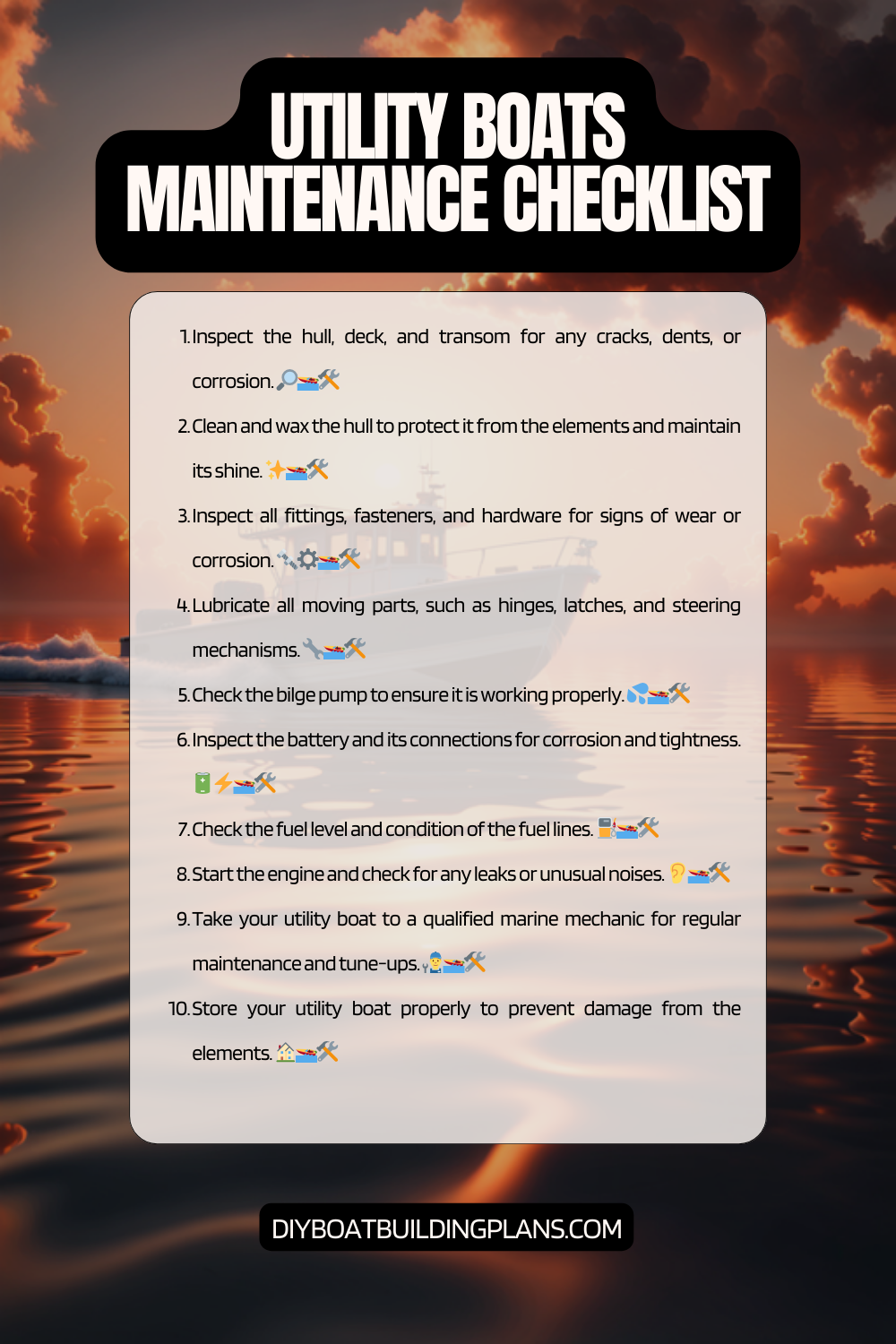Overview of Utility Boats Maintenance Tips
Utility boats are versatile watercraft designed for various purposes, such as transportation, fishing, and recreational activities. These boats are known for their durability and functionality, making them essential for individuals who rely on waterways for their livelihood or leisure. Utility boats come in different types, including jon boats, skiffs, and dinghies, each with its own unique features and capabilities.
The importance of utility boats cannot be overstated. They play a crucial role in industries such as fishing, search and rescue operations, and transportation of goods and people. Utility boats are also popular among outdoor enthusiasts who enjoy activities like fishing, water skiing, and exploring remote areas. Their versatility allows them to navigate through different water conditions, making them reliable companions for any water-based adventure.
Key Takeaways
- Regular maintenance is crucial for the longevity and performance of utility boats.
- Preparing for maintenance involves gathering necessary tools and materials.
- Cleaning and polishing the hull helps prevent damage and maintain appearance.
- Checking and replacing engine oil, propellers, fuel filters, and lubricating moving parts are essential maintenance tasks.
- Properly storing the boat after use can prevent damage and prolong its lifespan.

Importance of Regular Maintenance
Regular maintenance is vital to ensure the longevity and optimal performance of utility boats. Neglecting maintenance can lead to a range of issues that can compromise the safety and functionality of the boat. By prioritizing regular maintenance, Utility Boats owners can enjoy several benefits.
One of the key benefits of regular maintenance is the prevention of major breakdowns or malfunctions. By conducting routine inspections and addressing minor issues promptly, boat owners can avoid costly repairs or replacements down the line. Regular maintenance also helps to identify potential problems before they escalate into more significant issues that could leave the boat stranded or unsafe.
Neglecting maintenance can have severe consequences. For instance, failing to clean and maintain the hull can result in the accumulation of algae, barnacles, and other marine growth, which can increase drag and reduce fuel efficiency. Ignoring engine oil checks and replacements can lead to engine damage or failure. Neglecting electrical system maintenance can result in electrical malfunctions or even fires. These consequences highlight the importance of regular maintenance in keeping utility boats in optimal condition.
Preparing for Maintenance
Before diving into maintenance tasks, it is essential to gather the necessary tools and materials. This includes items such as cleaning solutions, brushes, polishing compounds, oil filters, propeller wrenches, lubricants, and fuel filters. Having these tools readily available will streamline the maintenance process and ensure that all tasks can be completed efficiently.
Safety should always be a priority when performing maintenance on a utility boat. It is crucial to ensure that safety measures are in place before starting any work. This includes wearing appropriate protective gear such as gloves, goggles, and life jackets. Additionally, it is important to disconnect the boat’s battery and turn off all electrical systems to avoid any accidents or electrical shocks.
Scheduling maintenance is another crucial aspect of boat care. By setting a regular maintenance schedule, boat owners can stay on top of necessary tasks and prevent issues from arising. This can be done by creating a checklist of maintenance tasks and setting reminders or alarms to ensure they are completed in a timely manner.
Cleaning and Polishing the Hull
| Task | Frequency | Time Required | Tools Required |
| Cleaning the Hull | Monthly | 2-3 hours | Soft-bristled brush, bucket, soap, water hose |
| Polishing the Hull | Bi-annually | 4-6 hours | Polishing compound, buffing pad, electric buffer, microfiber cloth |
| Inspecting for Damage | Annually | 1-2 hours | Flashlight, scraper, sandpaper, epoxy, fiberglass patch kit |
Cleaning and polishing the hull is an essential part of boat maintenance. Over time, the hull can accumulate dirt, grime, algae, and other marine growth that can affect the boat’s performance. Cleaning the hull not only improves the boat’s appearance but also helps maintain its efficiency.
To clean the hull, start by rinsing it with fresh water to remove loose debris. Then, use a mild detergent or boat-specific cleaning solution to scrub away any stubborn dirt or stains. It is important to use non-abrasive brushes or sponges to avoid damaging the hull’s surface. After cleaning, rinse the hull thoroughly with fresh water to remove any residue.
Polishing the hull helps protect it from UV damage and gives it a shiny finish. Before polishing, make sure the hull is completely dry. Apply a marine-grade polish using a soft cloth or applicator pad in circular motions. Allow the polish to dry according to the manufacturer’s instructions, and then buff it off with a clean cloth. Regularly cleaning and polishing the hull will not only enhance the boat’s appearance but also prolong its lifespan.
Checking and Replacing the Engine Oil
Engine oil is the lifeblood of any boat’s engine. It lubricates the moving parts, reduces friction, and helps dissipate heat. Regularly checking and replacing the engine oil is crucial to ensure the engine operates smoothly and efficiently.
To check the engine oil, start by warming up the engine to operating temperature. Then, turn off the engine and locate the dipstick. Remove the dipstick, wipe it clean with a cloth, and reinsert it fully. Remove the dipstick again and check the oil level. The oil should be between the minimum and maximum marks on the dipstick. If the oil level is low, add the recommended oil type until it reaches the proper level.
Replacing the engine oil should be done according to the manufacturer’s recommendations, typically after a certain number of hours of operation or at regular intervals. To replace the oil, start by draining the old oil from the engine using an oil drain pan. Remove the old oil filter and replace it with a new one. Finally, refill the engine with fresh oil of the recommended type and quantity.
Inspecting and Replacing the Propeller
The propeller is a vital component of a utility boat’s propulsion system. Regular inspection and maintenance of the propeller are essential to ensure optimal performance and prevent any issues while out on the water.
To inspect the propeller, start by visually examining it for any signs of damage or wear. Look for dents, cracks, or bent blades that could affect its efficiency. If any damage is detected, it is important to replace the propeller promptly to avoid further complications.
Replacing a propeller can be done by following a few simple steps. First, remove the cotter pin or lock nut that secures the propeller to the propeller shaft. Use a propeller wrench to loosen and remove the propeller. Clean the propeller shaft and apply a thin layer of anti-seize compound before installing the new propeller. Secure the new propeller with a cotter pin or lock nut, ensuring it is properly tightened.
Maintaining the Electrical System
The electrical system of a utility boat is responsible for powering various components such as lights, navigation systems, pumps, and accessories. Regular maintenance of the electrical system is crucial to ensure its reliability and prevent any electrical malfunctions.
To maintain the electrical system, start by visually inspecting all wiring connections for signs of corrosion, loose connections, or frayed wires. Clean any corroded terminals using a wire brush and apply dielectric grease to prevent further corrosion. Tighten any loose connections and replace any damaged wires.
It is also important to check the battery’s condition regularly. Ensure that the battery terminals are clean and free from corrosion. Test the battery’s voltage using a multimeter to ensure it is within the recommended range. If the battery is low on charge or not holding a charge, it may need to be replaced.
Troubleshooting electrical issues can be challenging, but there are some common tips that can help. Start by checking all fuses and circuit breakers to ensure they are not blown or tripped. Inspect switches and controls for any signs of damage or malfunction. If an electrical issue persists, it may be necessary to consult a professional electrician or boat mechanic for further assistance.
Checking and Replacing the Fuel Filter
The fuel filter plays a crucial role in maintaining the cleanliness of the fuel system in a utility boat. Regularly checking and replacing the fuel filter is essential to prevent contaminants from reaching the engine and causing damage.
To check the fuel filter, locate it in the fuel line between the fuel tank and the engine. Remove the filter and inspect it for any signs of clogging or contamination. If the filter appears dirty or clogged, it is important to replace it with a new one.
Replacing the fuel filter can be done by disconnecting the fuel lines from the old filter and connecting them to the new filter. Ensure that the fuel lines are properly secured and that there are no leaks. It is also important to prime the fuel system after replacing the filter to remove any air pockets.
Regularly checking and replacing the fuel filter will help maintain the efficiency of the boat’s engine and prevent any fuel-related issues while out on the water.
Lubricating Moving Parts
Lubrication is essential for keeping the moving parts of a utility boat in optimal condition. It reduces friction, prevents wear and tear, and prolongs the lifespan of various components.
To lubricate moving parts, start by identifying all the components that require lubrication, such as hinges, throttle cables, steering mechanisms, and winches. Use a suitable lubricant, such as marine-grade grease or oil, and apply it according to the manufacturer’s instructions.
When lubricating hinges or other moving parts, ensure that excess grease or oil is wiped away to prevent dirt and debris from sticking to it. Regularly lubricating moving parts will help maintain their functionality and prevent premature wear.
Download over 500 Boat Plans. Click on the link below.
-->Click Here<--
Storing the Boat Properly
Proper storage is crucial for maintaining a utility boat’s condition during periods of non-use, such as winter months or extended periods between outings. By following proper storage practices, boat owners can ensure their vessel remains in optimal condition for years to come.
One of the key aspects of proper storage is finding a suitable location. Ideally, boats should be stored in a covered area such as a garage or boat storage facility to protect them from harsh weather conditions and UV damage. If indoor storage is not available, using a boat cover or shrink-wrapping the boat can provide some protection.
Before storing the boat, it is important to clean it thoroughly, both inside and out. Remove any dirt, debris, or marine growth from the hull, deck, and interior. Drain all water from the bilge and plumbing systems to prevent freezing and damage.
Winterizing the boat is essential for those in colder climates. This involves draining all water from the engine, flushing it with antifreeze, and treating the fuel system to prevent ethanol-related issues. It is recommended to consult the boat’s owner’s manual or a professional for specific winterization procedures.
Utility Boats Maintenance Checklist

Conclusion – Utility Boats Maintenance Tips
In conclusion, regular maintenance is crucial for keeping utility boats in optimal condition. By following the maintenance tips outlined in this article, boat owners can ensure their vessels remain reliable, safe, and efficient.
From cleaning and polishing the hull to checking and replacing engine oil, propellers, fuel filters, and maintaining the electrical system, each aspect of maintenance plays a vital role in the overall performance of a utility boat. Additionally, proper storage and winterization practices are essential for protecting the boat during periods of non-use.
By prioritizing regular maintenance and addressing any issues promptly, boat owners can enjoy their utility boats for years to come. Remember, a well-maintained boat not only enhances safety but also enhances the overall boating experience. So take care of your utility boat and enjoy all the adventures that await on the water!
FAQs – Utility Boats Maintenance Tips
What are utility boats?
Utility boats are small to medium-sized boats designed for various tasks such as transportation, fishing, and recreation. They are typically made of aluminum or fiberglass and can be powered by outboard motors or inboard engines.
Why is maintenance important for utility boats?
Maintenance is important for utility boats to ensure their safety, reliability, and longevity. Regular maintenance can prevent breakdowns, reduce repair costs, and extend the life of the boat.
What are some basic maintenance tasks for utility boats?
Basic maintenance tasks for utility boats include checking and changing the oil, inspecting and cleaning the propeller, checking and replacing the fuel filter, checking and topping off the fluids, and inspecting the hull for damage.
How often should utility boats be serviced?
Utility boats should be serviced at least once a year or after every 100 hours of use, whichever comes first. However, boats that are used frequently or in harsh conditions may require more frequent servicing.
What are some tips for maintaining the engine of a utility boat?
Some tips for maintaining the engine of a utility boat include changing the oil and oil filter regularly, checking and replacing the spark plugs, inspecting and cleaning the carburetor, and flushing the engine with fresh water after each use.
How can I prevent corrosion on my utility boat?
To prevent corrosion on your utility boat, you should rinse it with fresh water after each use, apply a protective coating to the metal parts, and avoid leaving the boat in saltwater for extended periods of time. You should also inspect the boat regularly for signs of corrosion and address any issues promptly.



